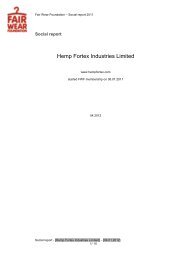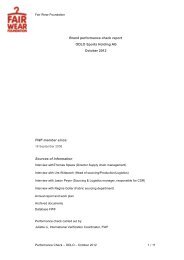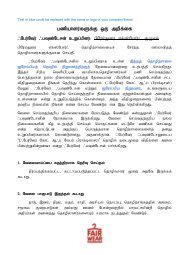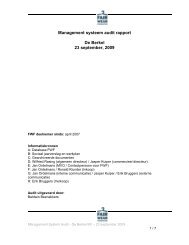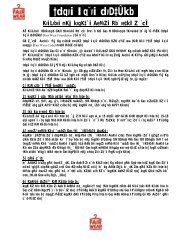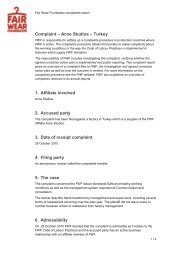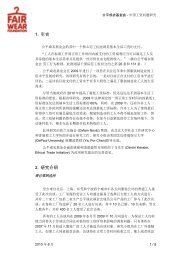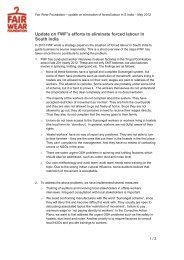Background Study Tirupur - Fair Wear Foundation
Background Study Tirupur - Fair Wear Foundation
Background Study Tirupur - Fair Wear Foundation
Create successful ePaper yourself
Turn your PDF publications into a flip-book with our unique Google optimized e-Paper software.
The Factories (Amendment) Act 1954 included a prohibition of employment of<br />
person’s under 17 years at night. Night is defined as a period of 12 consecutive<br />
hours and which included hours between 10 p.m and 7 a.m.<br />
Court Case: M.C.Mehta Vs State of Tamil Nadu (AIR 1977 SC699)<br />
The Supreme Court (SC) issued “directions to the State Governments regarding fulfilment of<br />
legislative intendment behind the enactment. The Court directed every employer who engaged<br />
children below 14 years to pay Rs 20,000 per child”. And SC held that “State Governments<br />
will be responsible for providing employment to every adult member of the family<br />
where children are working”. This verdict is an ample legal tool to provide relief to child workers.<br />
4.3.2. Compliance situation<br />
In general there is no child labour in the registered export units in <strong>Tirupur</strong>. But child labour is<br />
prevalent in the unregistered garment units according to the Factory Officials. The Inspector<br />
of Factories has launched more than 100 cases under the Factories Act, penal provisions<br />
under Child Labour (Prohibition and Regulation) Act, 1986. District Administration has taken<br />
much effort to eradicate child labour in the garments Industry. Since the garments industry is<br />
not termed as hazardous industry in the Child Labour (Prohibition and Regulation) Act, 1986,<br />
it is hard to prosecute the managements that employ less than 20 workers, since that unit will<br />
not come under the purview of Factory.<br />
12 to 14 years old children are sometimes found working. Now most of the major companies<br />
engage them only in peak season unlike few years ago but small and medium size companies<br />
employ them more frequently and in some cases as full time workers.<br />
Most of the child labour in the Indian garment industry is found in subcontracting shops or in<br />
homework situations. At least 5% of the <strong>Tirupur</strong> apparel production takes place in people's<br />
homes, with families carrying out operations such as attaching buttons and other accessories<br />
or operating a knitting machine.<br />
Birth registers – as known in Western countries – do not exist, making it extremely difficult to<br />
determine the exact age of a young worker. A medical doctor's certificate or school records<br />
may be the only ways to determine a person's age. (IIIED:85-86)<br />
Joshi quotes a figure of 20% of the 200,000 strong garments workforce in <strong>Tirupur</strong> to be children<br />
(page 63).<br />
4.4. Freedom of Association and the Right to Collective Bargaining<br />
4.4.1. Laws and Regulations<br />
The Trade Unions Act, 1926<br />
• Each employee has to inform the management about his choice of a union. If this union<br />
does not get registration he has to join another union recognized union within three<br />
months.<br />
• Any person above 15 years can become a member of a trade union. Only, he cannot be<br />
an office-bearer till he/she becomes 18 years old.<br />
• A person convicted for an offence will not be eligible to the executive of the union. However<br />
if he/she has completed 5 years after the release from jail can be eligible.<br />
• At least 50% of the office bearers of the registered trade union must be from the actually<br />
employed workers of a particular industry, which the union is connected.<br />
• Any office bearer of the union can inspect account books and list of members at suitable<br />
times fixed by the union.<br />
• And this acts describes more on membership fees and affairs related registration of the<br />
29




